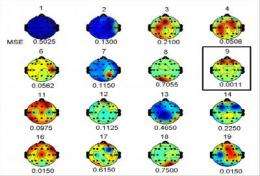Research project analyzes cerebral bioelectricity in order to detect epilepsy

A group of researchers from Universidad Carlos III de Madrid has presented a new algorithm that uses a new method to analyze the information obtained from electroencephalograms to detect neurodegenerative diseases, such as epilepsy, using the bioelectric signals of the brain.
The research project is a joint effort among engineers and doctors from UC3M, the Clínica Universitaria de Navarra and Universidad Pública de Navarra. It began as a collaborative project designed to discover and interpret bioelectric phenomenon originating in the cerebral cortex.
The objective of this research was to apply these studies to the analysis of different pathologies such as Parkinson's disease, Alzheimer or epilepsy. Electroencephalography was used as a means of obtaining cerebral signals. This technique uses electrodes placed on the surface of the scalp to perform a test that measures and records the electrical activity generated in the brain.
The first results recorded by the scientists were promising and showed a need to reduce the amount of information obtained from electroencephalograms due to the fact that the analysis of all the data requires a great deal of time and large processing capacity. In order to achieve this aim more efficiently, the scientists designed an algorithm that allows them to extract the most relevant characteristics of the signals associated with epilepsy. Thus, they are able to detect and classify more quickly epileptic seizures as well as determine which parts or areas of the brain are affected the most.
"The advantage of this method is that it allows us to detect, classify or identify neurological diseases with a small amount of information" says Carlos Guerrero Mosquera, one of the researchers from the Department of Signal and Communications Theory (Departamento de Teoría de la Señal y Comunicaciones) at UC3M. He adds, "Electroencephalograms contain a lot of information and what we are looking for is to try to improve the efficiency of the tasks carried out by analysing small amounts of information through the use of the most important data received from the signals."
Presentation to the public
This new method, published recently in the journal Medical & Biological Engineering & Computing, has been compared to other techniques and the results of this analysis will be presented at the International Conference of the IEEE Engineering in Medicine and Biology Society. This event, which is one of the most important biomedical engineering conferences, will take place in Buenos Aires (Argentina) from the 31st August until 4th September.
In general terms, this method can be divided into four fundamental processes: the acquisition of a signal through the use of electroencephalography, cleaning or pre-processing of the signal in order to eliminate noise and the extraction/selection of characteristics depending on how the information will be used. "The detection of data should follow a linear procedure but for the moment, we use databases", Carlos Guerrero points out. "At a later date, when the application shows positive results, we will try to reduce processing costs by the selection of specific characteristics."
The researchers explain that this method extracts information about the time and frequency pattern of the signal in a new and simple way. This makes it easier to detect and classify segments with epilepsy and opens up the possibility of applying the algorithm to other pathologies. "Initially this method was developed to classify and detect epileptic seizures, but in the future we wish to apply it to other neurodegenerative diseases such as Parkinson's, Alzheimer or the analysis of different sleep disorders," Guerrero explains.

















